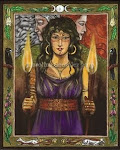
I like to read articles on Witchvox from time to time, and I came across a wonderful article on the Primordial Goddess, that I wanted to share. I did not post the whole article, as it is quite long, but I will post a link at the end so you can read the rest. Please read the rest, its really a fantastic article! Enjoy:
As we know, the Sumerians developed writing around 3200 BCE, and that marks the earliest point when we might receive any direct information from people who actually lived during that period. However, since the Kurgan invasion occurred from approximately 4000-2000 BCE, nearly all of our historical knowledge comes from a chaotic, post-Kurgan, polytheistic world... indeed, the vast majority of it is later than the Trojan War, and comes to us only through the Greeks and Romans. My topic in this essay concerns the primordial Great Mother Goddess... a story that began long before techniques of writing came into existence. In order to gain an understanding of that distant time, we must rely entirely on archeology; the examination of whatever remaining artifacts we can find.
The artifacts generally include the ruins of buildings, possessions such as pottery and tools, art objects, grave goods, and of course human and animal remains. As a science, archeology is a relatively recent phenomenon, having begun in earnest only a few centuries ago. Naturally, early attempts to recover the artifacts were clumsy at best. Precious objects were often destroyed by careless excavations, improper preservation, and looting. The total number of researchers involved in archeology was relatively low, and methods of recording and transferring data were tedious and unreliable.
Modern archeological techniques have greatly improved. There are far more people working in the field today, and the capability of computers to store and transfer data has made it possible for experts located virtually anywhere on Earth to collaborate. In addition, new technologies such as carbon dating, electron microscopes, ground-penetrating radar and DNA analysis are providing us with a wealth of insights and discoveries. Yet what has remained perhaps the most critical problem facing archeologists is the interpretation of the evidence. All too often, they allow their own cultural biases and preconceived ideas to color their work, and seem to find it very difficult to admit that certain long-held and commonly accepted beliefs may be wrong. Fear of ridicule and damage to their reputation frequently causes them to resist change, until a clear consensus develops in its favor.
True progress, on the other hand, has always depended upon people with foresight, and the courage to take a controversial stand... and Gordon Childe was just such a man. Born in Australia in 1892, Childe attended Oxford and spent most of his life in the UK. During the course of his career of roughly thirty years, he completely revolutionized our understanding of pre-history, and ultimately became the single most influential archeologist of the early 20th century. Unlike anyone before him, Childe presented an overview of human development, rather than merely a detailed description of some particular culture. Through a series of over 20 books, he established three key concepts, which today form the basis for our understanding of the pre-history of the western world. First, Childe demonstrated that the origins of human civilization were in the Near East, a fact that had been somewhat in dispute prior to that time. Second, Childe demonstrated that, following the end of the last ice-age (circa 10, 000 BCE) Europe was re-populated by people from the Near East, who introduced techniques of agriculture, the domestication of animals, woven fabrics, etc.
This was the true beginning of the civilization of Europe. Finally, Childe established that an invasion of Europe by people from western Russia and the Ukraine occurred around 4000-2000 BCE. He referred to these invaders as Proto-Indo-Europeans. They were a patriarchal warrior society, who followed a violent male god, practiced human sacrifice, believed in an after-life, and conducted elaborate burials in large mounds of earth called kurgans. Childe's work was based entirely on an examination of artifacts and linguistic evidence. However, since that time, a large number of new discoveries have been made which clearly confirm his findings. And in addition to his brilliant technical work, he will also be remembered as a man who made archeology more accessible to ordinary people, with such wonderful books as "Man Makes Himself" (1936) and "What Happened in History" (1942) . Another well-known archeologist who played a major role in changing the world's views of pre-history was Jacquetta Hawkes. Born in the UK in 1910, she attended Newnham College in Cambridge. It was there that she met her first husband, Christopher Hawkes, a working archeologist. She began to join him on digs, and although not afraid to get her hands dirty, it soon became clear that her greatest talent was her insightful and humanistic interpretation of evidence, and her eloquent style of communicating.
While working in the UK early on, she took special notice of a pattern of goddess-worship at Neolithic sites. Over time, she began to focus on the social and cultural role divisions resulting from gender, and questioned the belief that men had always been the dominant members of a community, while women were presumed to have merely played a secondary role. Yet, it was not until Hawkes started to explore the fabulous legacy of the Minoan civilization of Crete, that she found overwhelming evidence of a society in which women clearly played a leading role... and indeed, a society that was incredibly successful, peaceful and artistic. Through a remarkable series of books, newspaper and magazine articles, lectures, and radio and TV interviews, Hawkes demonstrated the existence of early gender-egalitarian cultures and primordial goddess-worship to the public, in ways that simply could not be ignored. Although her work was controversial at the time, and was occasionally dismissed as "feminist fantasy", Jacquetta Hawkes remained steadfast and outspoken.
Over time, new discoveries began to confirm her theories, and fortunately she lived long enough to receive some of the recognition and honors that she deserved. Archeologists Gordon Childe and Jacquetta Hawkes had the intelligence and insight to see beyond the mistaken presumptions of their peers, at a time when the evidence available to them was quite limited. However, if the archeological community needed indisputable proof, it was James Mellaart who would supply it... in an overwhelming quantity. Born in London in 1925, Mellaart seemed to posses a natural instinct for finding hidden ancient sites. Early in his career he made several amazing discoveries, including a large cache of bronze-age artifacts on Cypress, and a fully intact tomb in Jericho. Later, while wandering through the Turkish backcountry alone in 1956, he discovered the Neolithic site of Hacilar, which contained figurines suggestive of the Great Mother Goddess Cybele. Yet it was Mellaarts next discovery that would become the final catalyst for fundamental changes in the view of pre-history, throughout the entire archeological community.
In 1961, James Mellaart began the excavation of Catal Hoyuk, a site that would eventually be recognized as the most well-preserved Neolithic city that has ever been found. Here was a window into a world 9000 years removed from our own... agriculture, the domestication of animals, houses with built-in cooking ovens, pottery, woven fabrics, jewelry, mirrors made of polished black obsidian, stone knives and other tools... and best of all, from a spiritual standpoint, there were the shrines. A very high percentage of the houses contained shrines, and hundreds of carved figurines were found, of what undeniably was the primordial Great Mother Goddess, whom we now call Cybele.
Read the rest here: Witchvox: The Primordial Goddess
Blessings )O(
Picture courtesy of FreeWebs.com






